Spotlight: Harald Hauswald, the images of others, and the Stasi

In 1987, East German photographer Harald Hauswald published a book called “Ost-Berlin” (East Berlin) - in West Germany. An East German artist publishing in the West had to rub the leadership of East Germany, a Communist dictatorship, the wrong way. To make matters even worse, that same year, Berlin’s 750th anniversary was to be celebrated. Kurt Hager, the minister of culture in the East German politburo, thus wrote a letter to Erich Mielke, head of the infamous Ministry of State Security (known as “Stasi” and “widely regarded as one of the most effective and repressive intelligence and secret police agencies in the world” at that time [source]), to sic the Stasi on the photographer. Harald thus became an enemy of the state.
I met Harald during a recent trip to Berlin. While visiting Ostkreuz agency (which was founded after the Wall came down by a group of East German photographers, incl. Harald Hauswald), I spoke with a group of photographers, and at some stage, someone said “Harald had eight Stasi agents after him.”
“Actually, it was ten,” Harald (who had been sitting a little bit in the background) said, and when I started to ask him about the story, he sat down next to me to tell me. When he mentioned the report the Stasi had compiled about his work I asked him about it. He got up, looked through one of the shelves, brought back a stack of papers and showed it to me. There it was, a copy of the Stasi’s reaction to his book. Of course, I had heard about the Stasi reports before, but I had never actually seen one.
We talked about the book and the Stasi’s reaction a little bit. As it turned out, the Stasi had attempted to act a bit like a photo critic. For each of the photographs, there was an actual critique. It was pretty amazing. So I asked Harald whether he’d be willing to share this story. My idea was to show some of the photos from the book along with the Stasi’s comments from his reports. He immediately agreed to it.
Today, I found the images plus scans of some of the pages from the reports in my inbox. Harald had marked the relevant portions to make it easier to see what was going on. Amazing! I can only thank him for making this story available to a larger audience, especially one outside of Germany.
The book has since been re-issued in an expanded bi-lingual version. It’s a bit hard to find outside of Germany. Alibris.com seems to have some copies, there are some options here; maybe easiest would be German Amazon (remember, the book is bilingual anyway).
In the interest of making things a bit easier for the reader, I will give the Stasi’s reactions right after the photos, followed by my own translation (the translated text will be given using italics). To start everything off, this is what one of the pages (this one is the first) actually looks like.
From these pages I took the relevant sections for the following examples (as I said, Harald had marked them for me). Here’s the Stasi’s introduction to their report:
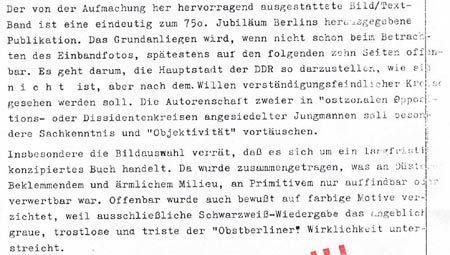
This well produced book, which contains text and images, was obviously published at the occasion of Berlin’s 750th anniversary. Its main purpose becomes obvious immediately, if not from its cover photo, then from the following ten pages. The idea is to present the capital of the GDR [East Germany’s official name was German Democratic Republic, GDR] not as it is, but according to the ideas of circles hostile to its constitution. The authorship of two young men from within opposition or dissident groups is intended to create a pretense of knowledge and “objectivity”.
Especially the selection of the images gives away that we are dealing with a book that has a long-term purpose. People gathered everything somber, oppressive, from poor neighbourhoods, or primitive they could find. It seems apparent that color was intentionally omitted, because only black and white reproduction stresses the supposedly gray, bleak and dismal reality of East Berlin.
The cover of the first book’s first (West German) edition:


The cover photo: Nothing against a technically interesting detail such as the cathedral mirrored in the windows of the Palast der Republik [East Germany’s parliamentary building, demolished recently]. But as the title its dominant message is: East Berlin behind bars! (note the translation here, and in the following, only covers the areas marked by Harald, using orange red; the “KOPIE BStU” lettering indicates that the page is a copy authorized by [united] Germany’s government agency in charge of the Stasi files)
and:

The title’s announcement that the book talked about the other side of a city using text and images isn’t even worth the red ink [remember, red was the colour of the Communist party!]. A basic idea, like a red thread [“red thread” here is just the translation of a German term], does not exist. All stylistic means of an image-based and emotional language are used to mix impressions, memories, real, invented, made up or lying stories into a hodgepodge of half truths and slander, presented to the reader as reality.
Onto some of the images:
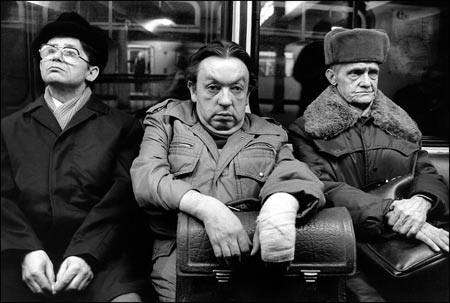
![]()
Three grumpy looking passengers in public transportation.
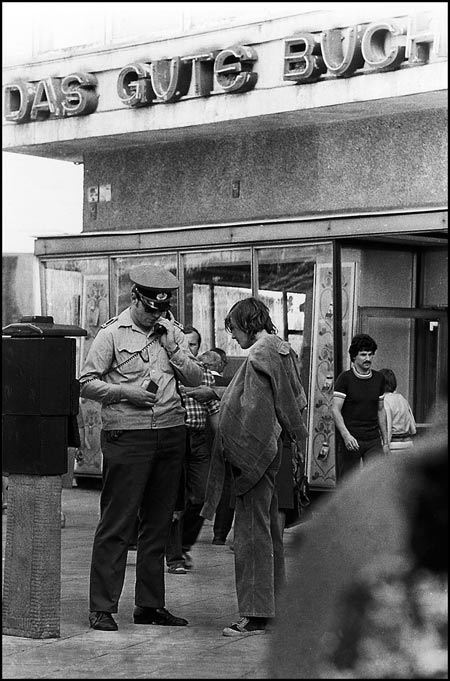
![]()
Police control - c.f. police state GDR


Apparently, bathing fashion show in “East Berlin” is really just crap: C.f. photo on page 50, apparently taken during a break, when only a few kids were prowling around.
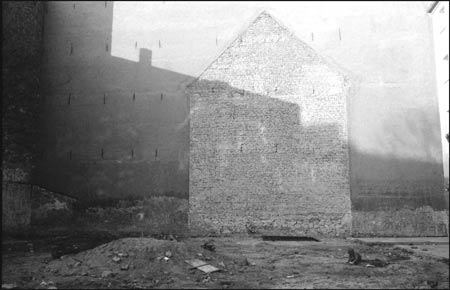

Page 63 contains a lot of run-down streets and houses, almost devoid of people, furthermore a photo of an empty playground. Where are the children? Every once in a while you see some in other photos, a couple of times even a lot of them. But to make sure this impression won’t last, on page 161 for example a large, empty, unplastered wall of a house, in front of which [you see] a child playing in the dirt: East Berlin slums! [Here, I translated the whole section]
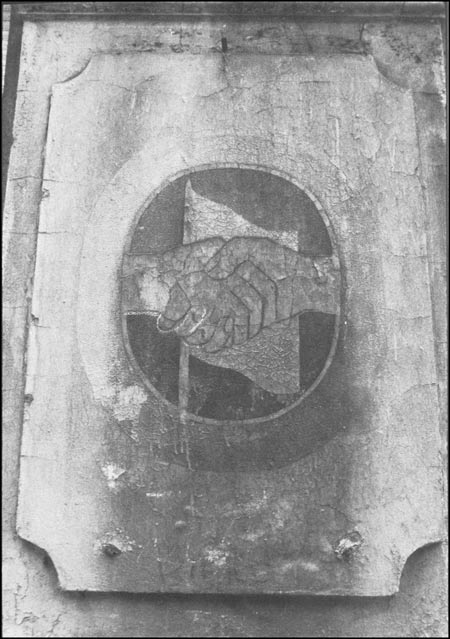

The more desolate, the more desirable. You gotta give it to Hauswald, he must have looked busily and maybe sometimes frustratingly long. Until he found “the withered symbol of the leading party”.Would there otherwise have been a chance for the symbol to find its way into the book? The answer is obvious.
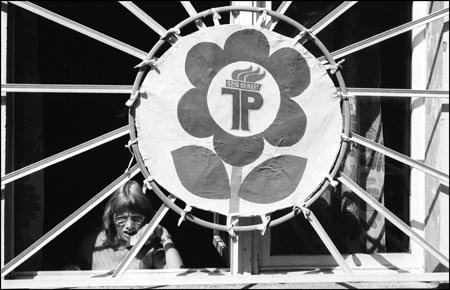

Just like on the cover Hauswald loves bars. According to the text: “Pioneer behind the symbol of her organization” Behind bars, against a dark background
About the first photo of this past, the Stasi had this to say: “Aufnahme von einer Gruppe Fahnenträger am Schluss der Maidemonstration 1987, wo bekanntlich ein Unwetter sich entlud. Hauswald hat genau den Moment abgepasst, wo eine für sich abgespaltene Fahnenträgergruppe von Regen und Wind durcheinandergewirbelt wird. Fahnenstangen kreuz und quer, gebeugte, sich mühsam haltende Fahnenträger. Übertragene Wunschvorstellung des Reporters?“ Translation: Photo of a group of banner/flag carriers at the end of the May 1st demonstration 1987, where, as is well known, a thunderstorm happened. Hauswald waited for exactly the moment when a separated group of banner/flag carriers is being messed up by the rain and wind. Flag poles here and there, banner/flag carriers barely able to remain on their feet. Projected wishful thinking of the reporter?